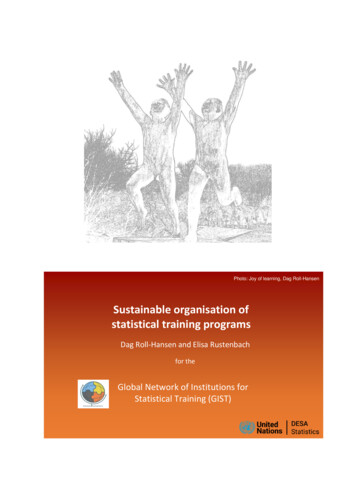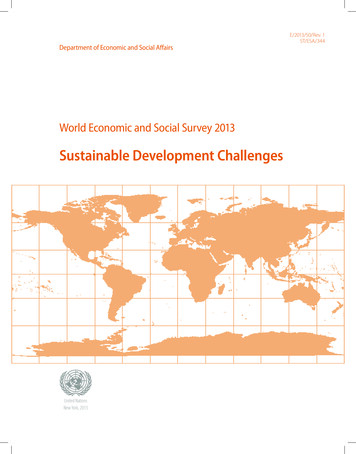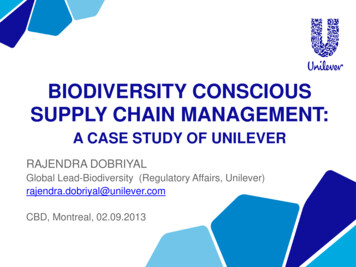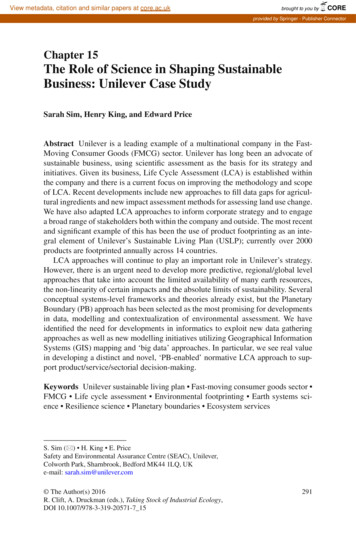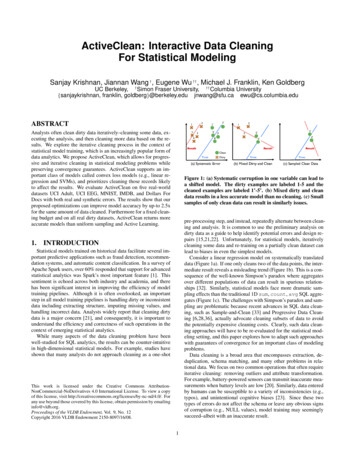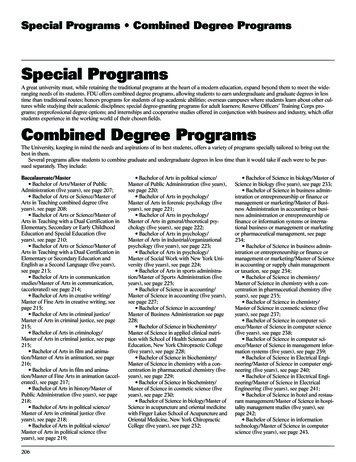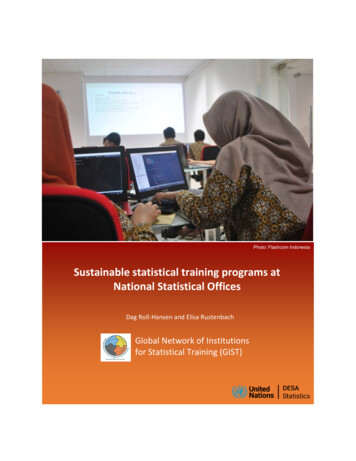
Transcription
Photo: Flashcom IndonesiaSustainable statistical training programs atNational Statistical OfficesDag Roll-Hansen and Elisa RustenbachGlobal Network of Institutionsfor Statistical Training (GIST)
SUMMARY4ORGANIZATION OF TRAINING PROGRAMS7Overview7Training Audience and Topic7Types of trainings offered9Training Organization and Staffing10Regional Training Centres13IDENTIFICATION OF TRAINING NEEDS17Process of identifying training needs17Ad Hoc Training17Assessment of Training Needs17Individual Gap Assessment17Summary of Identifying Training Needs19Relevance of training to participants needs19Career Development20Need for capacity development relating to SDG monitoring and emerging needs21New Staff22Management Training23NSS Training24External users25Need for capacity development relating to COVID-1925MEETING TRAINING NEEDS26Internal resources26Internal or external trainers26Pedagogical support28Time for and priority of training29National training providers30Regional and international training providers31Coordination between regional centres322
Motivation for teaching and learning33Resources for in-house training34Learning from sister organisations, networks and colleagues35Development cooperation between NSOs35Cooperation through social networks35On the job training and organisation of work to enhance learning36FOCUS ON E-LEARNING37e-learning as part of training programmes37Production of e-learning material in-house37E-learning as a common good39Online classes40Blended learning42The social element of learning43Efficiency43Summing up potential benefits of e-learning44EVALUATING TRAINING FOR CONTINUOUS IMPROVEMENT - LEARNING WHAT WORKS ANDWHAT IS NEEDED45RECOMMENDED ROLES OF THE GLOBAL, REGIONAL AND NATIONAL LEVEL47WAY FORWARD: A ROADMAP TO ENHANCE TRAINING PROGRAMS48Primary Recommendations48Other Findings51ANNEXES53Contacts in Countries53Contacts in Regional Training Centres54Glossary55Literature573
SUMMARYLike all workplaces, National Statistics Offices (NSOs) need to build the capacity necessary fortheir staff and particular circumstances within the overall global requirements for NSOs.International organisations which offer training in official statistics may advise on courses, butNSOs organise ongoing training programmes and frameworks appropriate for their staff andneeds. In addition, programmes or training units developed by or with NSOs often providetraining for other government entities in their countries. In some regions of the world, regionaltraining centres support NSOs in training their staff, mainly by helping to identify needs andsupply training.This report describes an investigation into how training is organised at NSOs and, whereappropriate, how they are supported by regional training centres to build the capacity theyneed. Training offered by NSO’s in countries where the NSO is not well established often lacksystematization. It is often ad hoc and focused on what is available rather than the specific skillneeds of the staff. Training also suffers from lack of prioritization. In countries where funding istight, training is often deprioritized at the expense of competing needs. In these contexts, staffmust rely on their own motivation and initiative to obtain training because they do not oftenhave comprehensive training at their fingertips.The Global Network of Institutes for Statistical Training (GIST), working to build sustainablestatistical capacities through efficient, effective, and harmonized delivery of training hascommissioned this report, aiming to find ways to further strengthen the capacity of NSOs. Thereport is funded by the UN Department of Economic and Social Affairs, Statistics Division(UNSD) who also acts as a secretariat for GIST.The aim of the report is to shed light on successes, challenges and needs related to establishingand further developing sustainable in-house training programmes. The investigation wasnecessarily restricted to a small number of countries and other statistical organizations, butthese were chosen to provide a good cross-section of types of situations. As always, cautionmust be applied to avoid unwarranted generalisation.Information on training programmes in fifteen countries were collected; Ethiopia, Morocco,Brazil, Dominican Republic, Nepal, Ireland, the Philippines, Nicaragua, Kyrgyzstan, Ukraine,Malawi, Mozambique, Senegal, Norway and Myanmar. For Kyrgyzstan and Ukraine, theinterviews were done in writing. For Myanmar representatives of the Central StatisticalOrganization (CSO) were not interviewed, but information was reported by UNDP working withCSO to build statistical capacity.4
Seven regional organisations supporting NSOs were interviewed, including EconomicCommission for Latin America and the Caribbean (ECLAC), Arab Institute for Training andResearch in Statistics (AITRS), Statistical Institute for Asia and the Pacific (SIAP), Ecole Nationalede la Statistique et de l’Analyse Economique du Sénégal (ENSAE), African Institute for EconomicDevelopment and Planning (IDEP), Eastern Africa Statistical Training Centre (EASTC), andStatistical, Economic and Social Research and Training Centre for Islamic Countries (SESRIC). ForAITRS the answers were submitted in writing.The interviews led to a variety of findings, among them we highlight four:1) Establishment of a repository of training material and tools that can be used as a globalcommon good could be cost-efficient and help NSOs have a common place wherequality training can be accessed. NSOs and regional organisations can adapt availablematerial to fit their needs and also make their material and tools available to others.2) A standard curriculum would give NSOs a starting point to identify their training needsand develop a training programme. It would also help organisations know where tofocus resources in developing training and training material. Guidance on how toorganise training could be beneficial for countries who are setting up or are in theprocess of improving their training programme.3) The establishment of a set of recommendations for training would help NSOs that arejust beginning to establish a training program to apply lessons learned from othercountries and effectively use the, often, minimal resources at their disposal. The focusshould both be on identification of training needs and organisation of training.4) Strengthening and clarifying the role of regional and international organizations inbuilding training programs at the country level is key to the overall advancement ofstatistics. Currently, the role of regional and international organizations varies widely,and it is likely that many efforts are duplicated or not leading to sustainable outcomes.Other findings of interest are highlighted in the final section of this paper. Among them are: Lack of time and resources is a common challenge both for trainers and participants.This can be helped by motivating experts in the NSOs to develop training through e.g.recognition and extra pay. Likewise, students would benefit from higher motivation fortraining through e.g. getting interesting tasks and opportunities for promotion. Strong support and commitment to funding for training from either the leadership ofthe NSO or someone higher in the government is key for the development of a strongtraining program.5
For every class taught, a staff member could be identified to become the instructor forfuture courses. This person ought to receive additional subject matter training andpedagogical support. The current pandemic has induced a shift towards online training. This includes bothtraining conducted face-to-face online and different types of e-learning. The data revolution and digitalization give many NSOs challenges they need support toface. Hence, these topics need focus among GIST members. Few existing programs evaluate the extent to which training has lasting impact on theproduction process.The aim of the report is to provide guidance and inspiration to NSOs and regional organisationstraining staff producing official statistics.6
ORGANIZATION OF TRAINING PROGRAMSOverviewThrough interviews with NSO’s and Regional Training Centers, a large variety of structures andpriorities were identified. Although not all aspects are covered in the current state of thetraining programs, there was some consensus on guiding principles of what the aims and tasksof a training programme should encompass:1. Identify training needs: both for NSOs needs, then needs of other parts of NSS, and forthe individual employee’s needs2. Prioritise training needs, and develop a training plan, considering needs in differentsectors3. Establish and increase sustained funding4. Develop systems for participants requesting training5. Develop processes for informing and selecting participants for training, prioritizingstudents that can have the largest positive impact from the training6. Identifying the right person or institution to conduct the training7. Ensure motivation, benefits and time for instructors within the organization8. Organising the training in terms of content, location, duration, scope, etc.9. Identify methods for courses to be offered in the long term, such as training of trainersor e-learning10. Market the training plan to solicit technical assistance and funding from relevantsources11. Evaluate training in terms of quality, whether objectives were met, and whether it isincreasing the skills within the organization over time12. Incorporate the needs of data users into training plansTraining Audience and TopicAll NSOs offering training programs have courses focused on improving statistical skills. Beyondthis, their scope varies widely in terms of audience and topic: Census and Survey Field Staff: Brazil, Senegal and Nepal are examples of countries thatinclude the training of field staff, such as enumerators and supervisors, for Censuses andSurveys under the umbrella of the training program. In countries such as the DominicanRepublic and the Philippines, these trainings are considered outside the scope of theNSOs training and fall in the duties of the field operations staff. Management Training: Morocco gives training in leadership and professionaldevelopment, and the Academy in Ukraine trains on interpersonal communication and7
professional development. The ENCE in Brazil has developed various e-learningmanagement courses. For example, they have a program that aims to reach out to localleaders dealing with data collection staff that includes courses on quality management,staff management, and monitoring procedures. Nepal and Ireland have a ministry ordepartment, separate from the training program focused on statistics, which offersmanagerial and soft skill training for civil servants. Staff at the Ireland CSO note thatthere is an online training platform with a large variety of offerings. Nepal’smanagement school is limited to middle and higher-level staff, usually with more thanten years of experience 1. National Statistical System: Most countries include members of the NSS in the trainingofferings, either as part of regular training, or specialized training for Ministries. InUkraine all training programs are available both for the NSO and for the entire NSS. InMyanmar the training centre serves the whole NSS, including government statisticians inall government ministries, aiming for harmonisation of the production of statistics. TheDominican Republic has a series of training courses oriented at improving metrics forthe Sustainable Development Goals that are offered to members of the NSS. PSRTI hascustomized full training courses for members of the NSS, such as a course on basicstatistics for official use for 17 regional offices of the Department of the Environmentand Natural Resources that was customized using their data. Other External Participants: Dominican Republic, Brazil and Norway have programs thataim at increasing statistical literacy and interest in schools. Various NSOs also offer sometraining to the media and researchers. Media training has e.g. been conducted inKyrgyzstan with support from UNDP and UN Women. Some NSOs surveyed presentstatistics to Members of Parliament in various ways, but none give training in usingstatistics to parliamentarians.The scope of regional training organisations is narrower. Most do not include training for fieldstaff and soft skills. Exceptions are SIAP, which offers courses on leadership and managementfor heads of NSOs and training of trainers and IDEP, which is developing a course on statisticalleadership. SESRIC used to include soft skills, but now have shifted the focus of their limitedbudget on the priorities of the Standing Committee for Economic and Commercial Cooperationof the Organization of Islamic Cooperation (COMCEC): 8 prioritized SDGs (i.e., SDG 1 (NoPoverty), SDG 2 (Zero Hunger), SDG 3 (Good Health and Well-being), SDG 4 (Quality Education),SDG 5 (Gender Equality), SDG 8 (Decent Work and Economic Growth), SDG 9 (Industry,Innovation & Infrastructure), and SDG 13 (Climate Action)); and 7 cooperation areas (i.e.,1 https://www.nasc.org.np/8
Agriculture, Finance, Poverty Alleviation, Private Sector, Trade, Transport & Communication,and Tourism).Most NSOs offer training for other members of the NSS. An exception is AITRS, which has a veryspecific scope that only includes the NSOs of the member countries. However, they do offertraining on how NSOs can lead the NSS. Finally, few offer trainings to other externalparticipants.Types of trainings offeredGiven the large variety of structures, scope and funding, it is not surprising that the trainingofferings also vary substantially across countries. The main types of offerings are as follows: Accredited higher education degrees(Bachelors, Masters, and/or Ph.D. Programs): InUkraine the Academy offers bachelor andmaster training in educational programmes onApplied Statistics and Business Analytics, it alsohas a training programme called OfficialStatistics qualifying both for work in the nationalstatistical system and enterprises submittingstatistical reports. The program lasts for one andGlobalisation and technical developmenta half years and currently has about 50 students.make training available across borders.The Academy in Ukraine also gives PhD trainingPhoto: Juliana Kozoskiin statistics. In Brazil, ENCE is an accreditedinstitution per the government and offers higherlevel degrees such as a Postgraduate in Population, Territory and Public Statistics.Senegal offers a Master of Science, Associates and Bachelor's degree in Statistics. Regular Training Courses: Both Philippines and the Dominican Republic have a list ofstatistical courses organised into topical clusters. They offer a subset of the coursesevery year. For example, PSRTI has a Statistical Modelling Cluster that includes threecourses: Regression Analysis, Time Series Analysis and Basic Forecasting and AdvancedForecasting Methods. Dominican Republic has clusters such as applied statistics, with sixcourse offerings or economic statistics. Morocco offers a variety of training courses suchas demography, business intelligence and statistics and data collection. The Academy inUkraine give two weeks trainings on data analysis and three weeks trainings on dataprocessing to about 300 participants annually. Usually the Academy also trains staff of9
the State Statistics Committee of Azerbaijan, but this was cancelled in 2020 due to thepandemic. Custom Training Courses: As noted, the Philippines creates and offers courses to anymember of the NSS or the Public (e.g. a financial institution) upon request. Even whenthe topic areas are common to PSRTI (e.g., basic statistics), they adapt the content touse the data from the organization to which the course is being offered. Webinars: Dominican Republic offers a series of short webinars on specific topics suchas COVID-19 statistics. The CSO in Ireland offers short presentations over lunch calleddata bytes. If there is enough interest, some of these presentations have beendeveloped into longer classes. Working groups: Brazil has organised working groups where, following a course or awebinar on a specific topic, participants are organised into discussion groups where theycan try to apply the learning to their own realities. Ireland is in the process of developingongoing working groups, where experts on specific topics can pass on their skills toyounger staff or share knowledge across thematic application areas.The regional training centres offer a similar variety of courses. SIAP has a long-term trainingprogram where participants live in Japan for 4 months and attend classes that give them basictraining on a wide array of statistical topics.Training Organization and StaffingThere is large variation in how training programmes are organised across the fifteen NationalStatistics offices described in this report. Many NSOs have, or have access to, a training unitand/or dedicated staff, but these vary in terms of the number of dedicated staff and how theunit is organised. Broadly speaking, four categories of organisation type were encountered: A national training institution that is separate from the NSO and its own entity withinthe government: The Philippine Statistical Research and Training Institute (PSRTI) wasestablished in 2013 as its own independent entity within the government after anevaluation of all ministries involved in the production of statistics. Prior to 2013, PSRTIhad been a training centre and there were four other primary entities involved in theproduction of statistics, each of which had some level of training available. Following theevaluation all five ministries were reconstituted into two: the Philippines StatisticalAuthority (PSA), which encompasses the equivalent of an NSO but also includes thestatistical authority for labour, economic and agricultural statistics and 2) the PhilippineStatistical Research and Training Institute (PSRTI), which is in charge of training instatistics for the PSA and all other members of the NSS, as well as any interested privatecompanies. The PSRTI has approximately 45 permanent staff and is currently in the10
process of getting additional positions approved. They aim to have a total of 75 staff inthe next few years.In Ukraine the Academy is a functional body within the NSS and is a higher educationalinstitution that has existed since 1992. Until then, it was Ukrainian branch of MoscowInterdisciplinary Institute of Advanced Training of Professional Accounting and Statisticsof the State Statistics Committee of the former Soviet Union. With Ukraine proclaimingits independence the Educational Institution has changed its status and concept ofeducational activities towards training and retraining of specialists in economicspecializations and statistics. Formal units within the NSO that have established a school or institute often providingtraining across government entities: Seven of the interviewed countries fit thisdescription: Brazil, Dominican Republic, Morocco, Mozambique, Senegal, Myanmar andKyrgyzstan. In 1953 Brazil established the National School of Statistical Sciences (EscolaNacional de Ciências Estatísticas or ENCE) as a department of their NSO, theInstituto Brasileiro de Geografia e Estatistica (IBGE). The school operates in itsown space and has about 100 permanent employees that are largely instructorsand course creators. The ENCE is an accredited institution recognized by theGovernment of Brazil. It has a department with 25 employees that focuses ondeveloping and implementing training for IBGE’s staff and, to a small extent, thegeneral public. The rest of the staff focus on sustaining the academic activities,including research and teaching at graduate and post-graduate levels. The National School of Statistics (Escuela Nacional de Estadística or ENE) wasestablished within the Oficina Nacional de Estadística (ONE) of the DominicanRepublic in 2006 as a result of funding provided by the Inter-AmericanDevelopment Bank (IDB). The ENE has a permanent staff of five: a schooldirector, an administrative assistant, an academic planning manager, anacademic coordination manager and an academic coordination analyst. The ENEhas its own classroom space that it shares with the rest of the ONE. The ENEdoes not hold its own official accreditation. Morocco: The school is part of the High Commission for Planning (HCP), the NSOof Morocco. The training program is a strategic component in the HCP HumanResources policy, organised under the Human Resources and General AffairsDepartment, and establishes and conducts a wide and varied trainingprogramme to meet the learning needs of the employees. In addition to the inhouse training, there is a statistical school covering all NSS, using full timeinstructors.11
Mozambique: A Statistical school opened in 2008, organised under the HR andAdministration-department at Instituto Nacional de Estatística (INE), the NSO ofMozambique. The main mission of the school is to provide training to promote astatistical culture and train mid-level professionals as well as giving shortcourses. Experts from INE do the training. Senegal: Ecole nationale de la Statistique et de l’Analyse Economique (ENSAE), aschool within the NSO, belongs to a network of African statistical schools,organised by le Centre d’Appui aux Ecoles de Statistique Africaines (CAPESA). Theschool is part of the Agence Nationale de Statistique et de la Démographie(ANSD), the NSO of Senegal. Myanmar: The Central Statistical Organization is in the process of establishing aStatistical Training Centre (STC) to provide a broader training program for itsown staff as well as staff of statistical units in other agencies in the NSS. Kyrgyzstan: A training centre called the Institute of Statistical Research andCapacity Building (ISRCB) is a subordinate body of the National StatisticalCommittee (NSC), the NSO of Kyrgyzstan. It is funded over the state budget. Formal unit within the NSO with dedicated staff but no officially established school:Ireland, Ethiopia, Nepal and Norway fall into this category. The Central Statistics Office (CSO) in Ireland has a training unit with fourdedicated staff: a statistician, an administrative manager, an executive officerand a clerical officer. The unit reports directly to the Head of HR Learning &Development and has a dedicated training space on site. The training unit hasadopted a new training framework that they have been developing and utilizingfor the past several years. Ethiopia: A training program exists for staff of the Central Statistics Agency (CSA),the NSO of Ethiopia. It has been in existence for 7 years but is still not fullyoperational. The training program has a dedicated building, and the staff areworking to establish and develop a system for course administration and acurriculum. Nepal’s Central Bureau of Statistics (CBS) has four staff members with astatistical background dedicated to training. The training unit is in the Planningand Human Resources Management Division l and does not have dedicatedtraining space. Norway: In-house school, organised by the HR-division in Statistics Norway. Onestaff member coordinates most in-house training in the organisation as her maintask, others support as need be.12
No formal training unit or staff dedicated to training: The National Institute of Development Information or Instituto Nacional deInformación de Desarrollo (INIDE) in Nicaragua has no staff dedicated to training.Training needs are handled as they arise by the HR department. However, in2018 the IDB funded a consultancy to identify training needs and establish atraining program that will go through 2022. Malawi National Statistics Office (NSO) has no operational training program.They established an internal training centre, which ran for 2-3 years but thenstopped. The training centre was basically established to give training directlyrelevant for the work staff do, by bringing individuals together and havinginternal trainers to do the training.For purposes of this paper, we will be referring to the described training programmes as NSOtraining programmes. Apart from the first category, all of the training programmes originatefrom units or staff housed within the NSO. The two exceptions, PSRTI and the Ukraine, have theNSO of their respective countries as their primary audience and will in the following also bereferred to as NSO training programmes.Regional Training CentresThe seven regional training centres interviewed also varied widely regarding organization oftheir training. Headquartered in Chiba, Japan, the Statistical Institute for Asia and the Pacific(SIAP) was established in 1970 as a centre for statistical training. It has two managers that comefrom a statistical background that assist in the training and four full-time lecturers. Eachlecturer has a subject matter focus but the unit works collaboratively on the training.The Arab Institute for Training and Research in Statistics (AITRS) began in the sixties as a resultof an initiative from UNDP as a regional centre for training on agricultural statistics in the ArabRegion. It evolved over time and formally became known as AITRS in 1977. It is headquarteredin Amman, Jordan.The Statistical, Economic and Social Research and Training Centre for Islamic Countries (SESRIC)was founded as a subsidiary organ of the Organisation of Islamic Cooperation (OIC) by the 8thIslamic Conference of Foreign Ministers (ICFM), held in Tripoli in May 1977. SESRIC started itsactivities in Ankara in Turkey on 1 June 1978. Within the framework of its Statistical CapacityBuilding (StatCaB) programme for the National Statistical Offices (NSOs) of OIC countries,SESRIC collects information from NSOs, assesses their needs and capacities, and matches theseneeds and capacities through organizing statistical capacity development activities.13
The Economic Commission for Latin America and the Caribbean (ECLAC) was established in1948 and is headquartered in Santiago, Chile. ECLAC has no team dedicated to training. Rather,it is organised by subject matter teams such as statistics, gender affairs, economicdevelopment, and natural resources.The Eastern Africa Statistical Training Centre (EASTC) in Dar-es-Salaam in Tanzania, serves as acentre for training in statistics for English-speaking African countries. EASTC has their owntrainers and give both short courses and training of longer duration.The African Institute for Economic Development and Planning (IDEP) located in Dakar, Senegalis a training institute of the UN Economic Commission for Africa (ECA), focusing on use of datafor policy development. They are supporting development agendas, focus on developmentplanning, e.g. trade policies including data analysis and gender policy management. They have astrong quantitative component.The ENSAE is a training centre serving the NSO of Senegal as well as other French speakingAfrican countries. It is part of a consortium of four African statistical schools (ENSEA Abidjan,ISSEA Yaoundé, ENEAM Benin and ENSAE Senegal) , centered around le Centre d’Appui auxEcole Africaines de Statistiques (CAPESA).In addition to the seven centres described above, the national Academy in Ukraine has capacityto create an International Statistical Institute for the Eastern Europe, Caucasus and Central Asia(EECCA) countries, aiming to strengthen the potential of national statistical systems in theproduction and dissemination of quality statistic.Most of the NSOs interviewed have limited funding for training. All of them cover the staffsalaries when they are developing and implementing training, as well as the time of the staffparticipating in the training, as long as that training was approved. Most NSOs also have limitedfunds for travel and accommodation for training offered outside the city where the NSO islocated. Often, when multiple people request the same external training that has a cost, onestaff member is chosen and that person shares their acquired knowledge upon their return, inorder to train more staff with existing resources. In most countries, there was no clear systemfor identifying the participant who would travel for training. Often it fell to the most seniormember of the staff that demonstrated interest.There are countries with governmental rules surrounding funding that affect the format andlocation of the training. In many countries training must be given at a certain distance from themain place of work, for the participants to receive daily allowances. As a consequence of beingfar from the main office, certain classes have more difficulty acquiring the necessary teaching14
materials, such as a laptop per participant. We also found economic incentives to have trainingoutside the headquarters in other NSOs, among them in Malawi, Mozambique and Kyrgyzstan.Most NSOs offer the training they create for free to the participants for which the training hasbeen created. An exception is PSRTI in the Philippines which offers both a regular catalogue ofcourses and custom courses. All regular courses are offered to the public but have asubstantially lower fee for civil servants. Custom training courses are usually developed at therequest of an outside party. For these courses, the government covers the salaries of the PSRTIemployees, and an agreement is created with the requesting party to fund any externalinstructors, participant fees and other expenses, such as utilities and electricity. Anotherexample is the Ecole Ecole nationale de la Statistique et de l’Analyse Economique du Sénégal(ENSAE), which charges a fee for participating in short term training that qualifies the individualfor working in the field and other data collection activities.Concerns over limited funding have increased as a result of the pandemic. Some governments,such as Malawi and Mozambique, have frozen the hiring of new employees. Others havereduced go
managerial and soft skill training for civil servants. Staff at the Ireland CSO note that there is an online training platform with a large variety of offerings. Nepal’s management school is limited to middle and higher-leve
